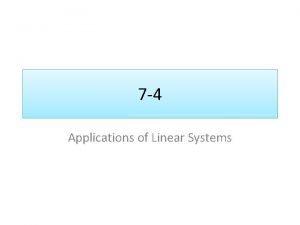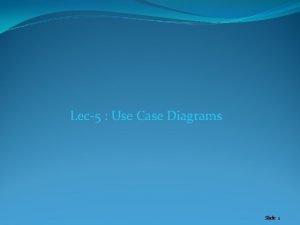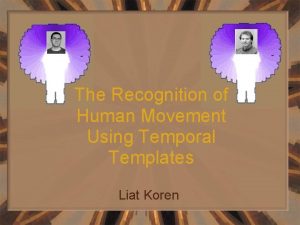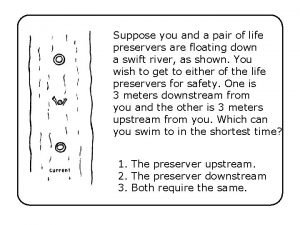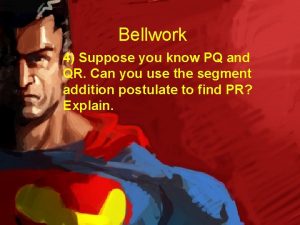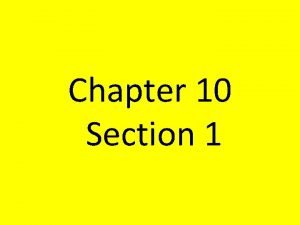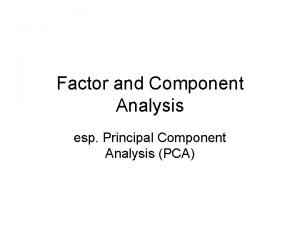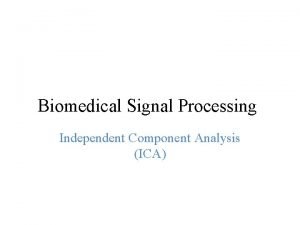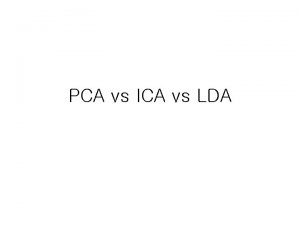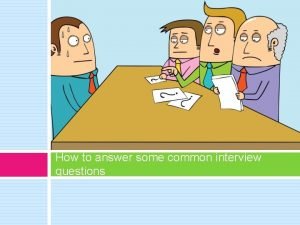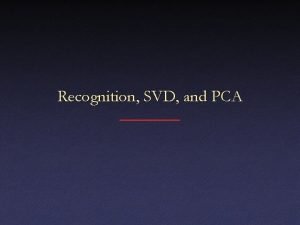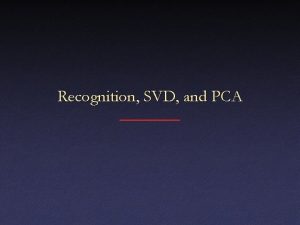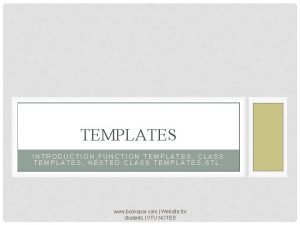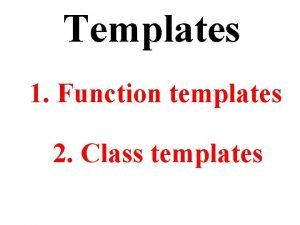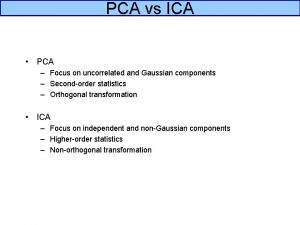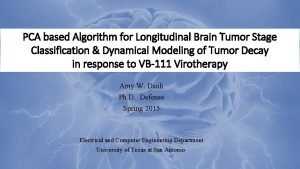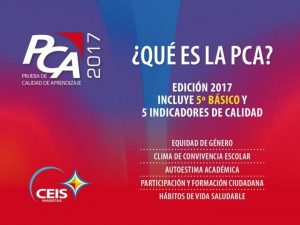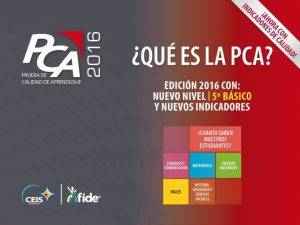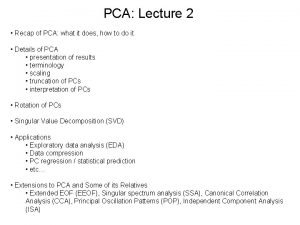Recognition PCA and Templates Recognition Suppose you want




















- Slides: 20

Recognition – PCA and Templates

Recognition • Suppose you want to find a face in an image • One possibility: look for something that looks sort of like a face (oval, dark band near top, dark band near bottom) • Another possibility: look for pieces of faces (eyes, mouth, etc. ) in a specific arrangement

Recognition • Suppose you want to recognize a particular face • How does this face differ from average face

Templates • Model of a “generic” or “average” face – Learn templates from example data • For each location in image, look for template at that location – Optionally also search over scale, orientation

Templates • In the simplest case, based on intensity – Template is average of all faces in training set – Comparison based on e. g. SSD • More complex templates – Outputs of feature detectors – Color histograms – Often combine position and frequency information (wavelets)

Face Detection Results Wavelet Histogram Template Sample Images Detection of frontal / profile faces

More Face Detection Results Schneiderman and Kanade

How to Recognize Specific People? • Consider variation from average face • Not all variations equally important – Variation in a single pixel relatively unimportant • If image is high-dimensional vector, want to find directions in this space along which variation is high

Principal Components Analaysis • Principal Components Analysis (PCA): approximating a high-dimensional data set with a lower-dimensional subspace * * Second principal component * * * First principal component * * ** * Original axes * * * Data points

Principal Components • Computing PCA: – Subtract out mean (“whitening”) – Find eigenvalues of covariance matrix – Equivalently, compute SVD of data matrix

PCA on Faces: “Eigenfaces” Average face First principal component Other components For all except average, “gray” = 0, “white” > 0, “black” < 0

Using PCA for Recognition • Store each person as coefficients of projection onto first few principal components • Compute projections of target image, compare to database

Recognition Using Relations Between Templates • Often easier to recognize a small feature – e. g. , lips easier to recognize than faces – For articulated objects (e. g. people), template for whole class usually complicated • So, identify small pieces and look for spatial arrangements – Many false positives from identifying pieces

Graph Matching Head Arm Leg Body Arm Body Leg Leg Model Leg Head Leg Feature detection results

Graph Matching Head Arm low e b , o t t Nex Leg Body Ne xt Arm to, rig ht of Leg Constraints

Graph Matching Head Arm Leg Body Arm Body Leg Leg Combinatorial search Head Leg

Graph Matching Head Arm Leg Body Arm Body Leg Body Head OK Leg Leg Combinatorial search Leg

Graph Matching Head Arm Leg Body Arm Already assigned Leg Body Leg Leg Combinatorial search Head Leg

Graph Matching Head Arm Body Leg Violates Arm constraint Arm Body Leg Leg Combinatorial search Head Leg

Graph Matching • Large search space – Heuristics for pruning • Missing features – Look for maximal consistent assignment • Noise, spurious features • Incomplete constraints – Verification step at end
 Suppose you want to combine two types of fruit drink
Suppose you want to combine two types of fruit drink Alarm clock use case diagram
Alarm clock use case diagram The recognition of human movement using temporal templates
The recognition of human movement using temporal templates Spoken word poetry allows you to be anyone you want to be
Spoken word poetry allows you to be anyone you want to be An airplane makes a straight back-and-forth round trip
An airplane makes a straight back-and-forth round trip Suppose you know pq and qr
Suppose you know pq and qr Suppose you are shopping for a new backpack
Suppose you are shopping for a new backpack Randomness probability and simulation
Randomness probability and simulation The cask of amontillado critical thinking questions
The cask of amontillado critical thinking questions If a fly collides with the windshield of a fast-moving bus
If a fly collides with the windshield of a fast-moving bus You're quite wrong to suppose i shall regret what i did
You're quite wrong to suppose i shall regret what i did Pca and ica
Pca and ica Pca and ica
Pca and ica Pca vs ica
Pca vs ica Reported speech
Reported speech Lirik lagu more more more we praise you
Lirik lagu more more more we praise you More more more i want more more more more we praise you
More more more i want more more more more we praise you Why do you want to work for us
Why do you want to work for us Unit 5 grammar future time answers
Unit 5 grammar future time answers Go con ing
Go con ing So you want to be a social worker
So you want to be a social worker
